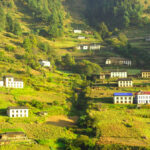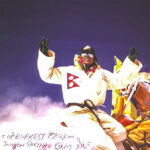Lopsang Jangbu Memorial Tour
he Three High Passes of Everest presentation takes you on a Sherpa supported expedition throughout the most historic trails in the Himalaya. Anyone who appreciates outdoor scenery and inspired tales of Sherpa heroism will enjoy the “top of the world” presentation.
“The tour is dedicated to the memory of Lopsang Jangbu Sherpa, who died at age 24 on the Lhotse Face of Everest, and who in a space of a few months taught me more about virtue and heroism than I ever dreamed possible.” KM Johnson
In the Himalaya there was the added dimension of climbing in the company of Sherpas, a people who were a product of the mountain environment, and as such to Westerners to embody the values and experiences they associated with the act of mountain climbing: purity, authenticity, transcendence, a cleansing of the doors of perception.
-“Fallen Giants,” Maurice Isserman and Stewart Weavers
Life long climber, author, and guide, Keith Mark Johnson’s slideshow celebrates a “life changing” trek throughout the Everest region. The expedition “of a lifetime” takes you over three 18,000 foot passes, (Rengo Lo, Cho La, Kungma La) and two 18,000 plus view summits, (Gokyo Ri and Kala Patar) with “up close” views of Everest, Cho Oyu, Ama Dablam, Lhotse, Baruntse, and Makalu. Like icing on a perfect cake, the trek culminates with the summit of Island Peak (20,305 ft.), renowned for being located amidst the great Himalayan giants.
“I’ve never hiked trails this easy, satisfying, and enjoyable. The Sherpa people do all they can to help foreigners feel welcome and cared for.”
-Langdon Towne
One of the myths of traveling in the Everest region is that it’s too tough, too cold, and too popular. In the best of times, the trail to Everest Base Camp was busy, yet the nearby trails to the great passes were lightly traveled. In the post earthquake days, all trails in the Everest region are too quiet. This not only affects the Sherpa guides, tea lodges, merchants, and hotels, but all the outlying villages whose men and women support the various treks and expeditions with porters, food, and supplies.
Our non-profit, Everest Aid, has shifted from fund raising to creating awareness of the realities in Nepal. Currently, the most important thing we can do for the devastated Sherpa villages is get trekkers and expeditions returning to the trails. Currently operations in Nepal are running at a fraction of normal. Each expedition to the Everest region affects the livelihoods of hundreds of Sherpas: from cooks, to guides, to those who grow the food, to tea lodge owners serving meals and treats, to venders, merchants, and porters. Our aim is to encourage adventurers to take their next vacation in Nepal, joining expeditions, and pumping life back into the devastated economy.
“This is not a show about climbing hard, or living some dream outdoor adventure life. I’m a nature lover who climbed in the Cascades, helped raise my kids, and lifted the burden of others whenever I could. Through grace and good fortune I met Pasang Bombu in the summer of ’96. This trip to Nepal with my friend (who grew up in a secluded Sherpa village near the Everest trail, and with education in the Hillary Schools, became one of the most respected and beloved ambassadors of the region) was the most incredible outdoor experience of my life.”
In Lionel Terray’s memoir, “Conquistadors of the Useless”… he praised the Sherpas “good heartedness, gaiety, tact, and sense of poetry.” Sherpa life seemed a utopia to disenchanted Westerners. Whenever Terray spent time in the company of the Sherpas, he wrote, “Dreams of a better world have always seemed to me suddenly less foolish.”
-“Fallen Giants,” Maurice Isserman and Stewart Weavers
Pasang Bombu Sherpa, president of Trek Himalayan, has been invited to WWU to share his story of growing up near Everest, his pursuit of education through the Sir Edmund Hillary Schools, and his rise to the pinnacle of the trekking and climbing industry. A life-long friend, Pasang is the co-founder of Everest Aid, a non-profit whose goal is to help rehabilitate and restore balance to devastated villages in the Everest region.
Keith Mark Johnson has adapted his Sherpa guiding skills to help people in inner city schools, gated communities, barrios, a reservation, and a super max prison. Thanks to climbing he is a citizen of the world. While guiding for Mountain Madness, Keith met Lopsang Jangbu Sherpa, one of the great high altitude climbers in the world. His show is dedicated to creating awareness of the beauty of Nepal, along with stories of the amazing Sherpa-Star who died at the age of 24. He will also share ideas on how to help out the Sherpa people whose lives were altered by the April Earthquakes in 2015.
“A stunning visual feast for anyone who loves mountains, Sherpas, and trails!” –Langdon Towne
In support of Everest Aid, Trek Himalayan LLC has over 20 years of Five Star experience leading foreigners on safe and successful trips throughout the Himalaya.
Having grown up in Nepal Pasang picked these two treks for people seeking various adventures:
The Three High Passes of Everest: Athletic, demanding, with mind bending views. This is full camping expedition is the hike of hikes, one of the great trail circuits in the world. Pasang Bombu Sherpa, who has hiked every trekking and climbing path in Nepal ranks this “top of the world” trail number one. (21-24 days)
Note: Temperatures, compared to mountains of Colorado or the Cascades, are relatively mild. You must acclimate and pay attention to your body in the first days of the trek. Staying well hydrated, well fed, and rested should be part of the team’s plan. After ascending the first difficult 18,000 pass and dropping to the relatively low elevation of 16,000 feet, anything below 14,000 feet will feel like sea level. The key is taking care of yourself the first week of the trek, slowly acclimating as you approach Namche, Thame, and Rengo La Pass.
Loding Service and Cultural Trek: A chance for those with service interests to help out hard hit villages. Local hikes will take trekkers to view points of Everest and the Himalayan giants, as well as monasteries, and cultural relics. This trip has great appeal to those on a spiritual quest, or feeling the need to give back to people who will appreciate the help. (18 days)
In the 1960’s Himalayan mountaineers did not need to imbibe their Buddhism secondhand through the works of Beat writers or British musicians. The could see Buddhism’s living embodiment in the Sherpas, a people they were coming to admire not only for their physical performance at high altitude but also for their apparent sense of spiritual harmony.
-“Fallen Giants,” Maurice Isserman and Stewart Weaver
Nepal Travel realities:
The most difficult challenge of hiking in Nepal is the epic plane flight to get there. Even the most veteran travelers grimace at the thought. It is long, expensive, and demands two-three days each way on either side of the trip. Then there is jet lag and all the apprehension that comes with international travel to a third world country. All I can say is the suffering is worth it. Adopt a Zen like attitude and enjoy the ride.
The shock of landing in third world Katmandu, and being drive about the noisy, dirty, overcrowded city is worth the price of admission. Overwhelming at first, the silence one soon experiences on the trail is a mind bending shift of perspective.
Tipping: two things one must keep in mind. We need to get people back to work so the more guides, porters, cooks, and help that are hired, the better. Tips are a way of life in Nepal. At first it might seem awkward, but after seeing how hard these people work on your behalf, you will soon wish you brought more cash.
Quotes about the Sherpa way:
In the Himalaya there was the added dimension of climbing in the company of Sherpas, a people who were a product of the mountain environment, and as such to Westerners to embody the values and experiences they associated with the act of mountain climbing: purity, authenticity, transcendence, a cleansing of the doors of perception.
-“Fallen Giants,” Maurice Isserman and Stewart Weavers
In Lionel Terray’s memoir, Conquistadors of the Useless… he praised the Sherpas “good heartedness, gaiety, tact, and sense of poetry.” Sherpa life seemed a utopia to disenchanted Westerners. Whenever Terray spent time in the company of the Sherpas, he wrote, “Dreams of a better world have always seemed to me suddenly less foolish.”
-“Fallen Giants,” Maurice Isserman and Stewart Weavers
Four years later (American) Dr. Tom Horbein offered an equally enthusiastic endorsement of life in the Sherpa communities he observed on the approach march to Everest: “It seemed to me that here man lived in continuous harmony with the land… He used the earth with gratitude…In this peaceful coexistence (with nature) man was the invited guest. It was an enviable symbiosis.”
-“Fallen Giants,” Maurice Isserman and Stewart Weaver
A brief conversation with Lopsang Jangbu
Lopsang was discussing his goals: He had a plan to scale Everest three times a year for enough years to break the oxygen-less record held by the aging Ang Rita Sherpa. I asked about money and material wealth and being famous.
“In my country, I bery pamous. Picture in newspaper. King and Queen of Nepal know me.”
“What about money? Americans make so much. Do you want to be rich like professional American athletes?”
“I not care bout money. I no climb por money. Money mean nutting to me.”
“But you, the Sherpa, are being paid poorly compared to American guides.”
“Yes, but $1.00 same as $70.00 rupee. Good money por me.”
“You’re still being ripped off, though.”
“No. Money mean nutting. When Lopsang climb Eberest eleben time wit no oxygen, and I bery pamous, I build school and monastery in my billage. I gib money to my people.”
Lopsang explained how his drive to climb was centered around a desire to be the best in the world, to be loved and admired. In many ways he was typical of any athletic genius in his early twenties who sees the world as his oyster. These athletic phenoms are rare. Griffey. Jordan. Gretzky. Lopsang was in that class, except his arena was in the death zone.






March 4, 2016